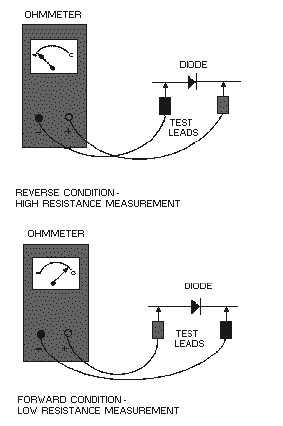1-33
Figure 1-28.—Checking a diode with an ohmmeter.
One thing you should keep in mind about the ohmmeter check-it is not conclusive. It is still possible
for a diode to check good under this test, but break down when placed back in the circuit. The problem is
that the meter used to check the diode uses a lower voltage than the diode usually operates at in the
circuit.
Another important point to remember is that a diode should not be condemned because two
ohmmeters give different readings on the diode. This occurs because of the different internal resistances
of the ohmmeters and the different states of charge on the ohmmeter batteries. Because each ohmmeter
sends a different current through the diode, the two resistance values read on the meters will not be the
same.
Another way of checking a diode is with the substitution method. In this method, a good diode is
substituted for a questionable diode. This technique should be used only after you have made voltage and
resistance measurements to make certain that there is no circuit defect that might damage the substitution
diode. If more than one defective diode is present in the equipment section where trouble has been
localized, this method becomes cumbersome, since several diodes may have to be replaced before the
trouble is corrected. To determine which stages failed and which diodes are not defective, all of the
removed diodes must be tested. This can be accomplished by observing whether the equipment operates
correctly as each of the removed diodes is reinserted into the equipment.
In conclusion, the only valid check of a diode is a dynamic electrical test that determines the diode’s
forward current (resistance) and reverse current (resistance) parameters. This test can be accomplished
using various crystal diode test sets that are readily available from many manufacturers.

